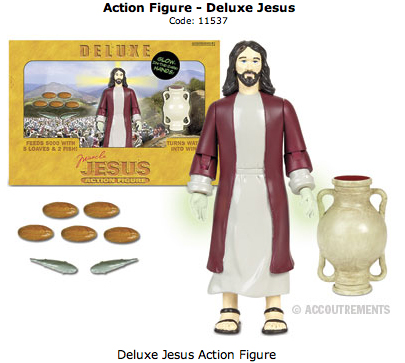Dr Vino's wine blog
wine talk that goes down easy
NYC wine service, foreign owners, Holy wine, tyramine – sipped and spit
SPIT: Wine tasting menus!
John and Dottie, WSJ wine columnists known for their sunny outlook, go negative on NYC wine pairing menus. Le Bernardin takes it the hardest. To the tape: “”Very little went right. The sommelier didn’t hear a word we said…Each white wine was served in the same kind of glass…not one of the seven wines we were served was poured from a full bottle…Most important to us, the pairings themselves were uninspired….We felt very much like we had been treated as hayseed tourists who ordered the tasting and wine-pairing menus only because we didn’t know how to pronounce the names of any of the dishes or wines.” Price: $280–for the wine only. And a parting shot on the phenom: “when we order the tasting menu, the restaurant puts us on its schedule, which is generally too rushed.” [WSJ]
SIPPED: Amazon swirls and sniffs
Move over Manuka honey: Amazon may soon sell wine along with its growing non-perishable grocery line according to the Financial Times today. This would be a welcome entrant into the brier patch of online wine retail. The more retailers, the merrier the wine consumer! The story has a mention of fellow wine blogger Tom Wark. [FT.com]
SIPPED: foreign owners in Bordeaux
Properties producing mid-range wines on the periphery of Bordeaux have been squeezed in recent years. But they may find relief from foreign buyers as evidenced by Haiyan Cheng, 28-year-old daughter of “vastly wealthy Chinese businessman,” Zuochang Cheng. She bought a property–a first for a Chinese buyer in the region–for $3 million and plans to renovate it and expand the vineyards. [NYT]
SPIT: Merlot (again), this time for headaches?
Merlot can’t get no lovin’. Malolactic fermentation may improve the taste of red wines but it also fills them with tyramines and histamines, which cause allergic reactions in many people. “Merlots seem to be particularly high,†UC Berkeley Professor of Chemistry Richard Mathies said although his research is inconclusive. [Red orbit]
SIPPED: Amen to that!
Taking Communion may soon help Chilean farmers get a fair price for grapes. The clergy and parishioners at Manchester Cathedral evaluate the wine today for potential introduction as possibly the world’s first “Fairtrade” Communion wine. Seventy percent of the churches in the Diocese serve Fairtrade tea and coffee. [BBC]
SIPPED: Drink for causes, part II
“For each bottle of wine you purchase as futures from his Lookout Ridge Winery, [Sonoma vintner Gordon Holmes (and former Wall Street publisher)] donates a wheelchair in your name to one of the world’s 100 million needy people desperate for mobility.” Andy Erikson of Screaming Eagle fame is one of the winemakers. (find this wine) [Bloomberg]
Stony Hill Chardonnay, Gewurztraminer, Riesling — and Syrah?
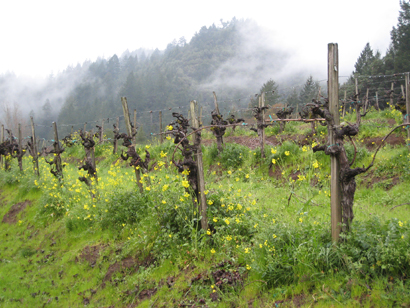
Sixty-year-old, dry farmed Riesling vines at Stony Hill Vineyards, Napa Valley
“We make a red wine.â€
Normally that’s not the sort of statement that raises an eyebrow in Napa Valley. But when one vintner told me that at dinner one night last week, I had to taste it for myself.
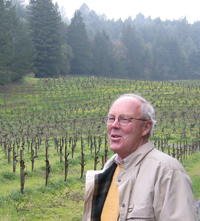 The vintner in question was Peter McCrea who owns Stony Hill. While most Chardonnay in the region receives lavish oak treatments and has high alcohol levels, Stony Hill Chardonnay is aged in 40-year-old (and therefore neutral) barrels and has 13 percent alcohol. His other two wines, a Gewurztraminer and a Riesling, roll in at 11.24 and 11.65 percent alcohol respectively. And at $21 a bottle, the wines stood out for another reason from the Napa wines.
The vintner in question was Peter McCrea who owns Stony Hill. While most Chardonnay in the region receives lavish oak treatments and has high alcohol levels, Stony Hill Chardonnay is aged in 40-year-old (and therefore neutral) barrels and has 13 percent alcohol. His other two wines, a Gewurztraminer and a Riesling, roll in at 11.24 and 11.65 percent alcohol respectively. And at $21 a bottle, the wines stood out for another reason from the Napa wines.
Not your average California whites. Which is why I jumped in a car with another wine writer and drove up to the winery the next day in pursuit of the red nobody has ever tasted outside of the winery: Stony Hill Syrah. Read more…
Entertainer-in-Chief: Part II, Schramsberg at the White House
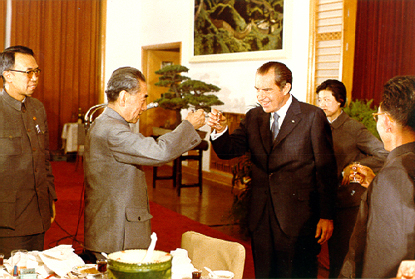
Schramsberg is an iconic American sparkling wine and it’s no surprise that it as been poured at the White House over 100 times. Last week, I caught up with Hugh Davies on the phone to ask him about the experiences for this second installment of our two-part mini-series, Entertainer-in-Chief. Two instances stood out to me of serving Schramsberg at state events.
Hugh, 42, told me that in 1972, his dad, Jack, got word from the Nixon White House that they would need 13 cases of Schramsberg 1969 blanc de blanc. And those cases had to be delivered to Travis Air Force Base. Hugh said that it was all a bit mysterious but his dad loaded up the cases into his jeep, drove them over to the Base where he got paid and left the wine.
Then three weeks later, images of Nixon’s historic trip to China were broadcast back to the US. And there was good old Nixon raising a glass of Schramsberg with Premier Zhou En Lai in a “toast to peace.” Hugh said that Barbara Walters reported from Tiananmen Square that Nixon and Zhou had just toasted with the Schramsberg “blank de blank.” Thirteen cases must have kept the whole delegation happy!
In what would be a bookend to state dinners and Schramsberg during Hugh’s mom’s lifetime, the Schramsberg brut rose 2004 was served at the state dinner with Queen Elizabeth II in Washington last year. The Teetoaler-in-Chief did not call and there was no drop-off at an AFB. Instead, the head usher just ordered it through the local distributor and Hugh didn’t even know it was being served.
Image credit, click through for more photos from the historic trip including this one, no doubt after the 13 cases of Schramsberg.
Entertainer-in-Chief: Part I, Thomas Jefferson
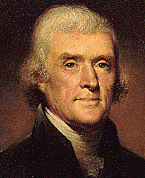 With President’s Day soon upon us in this election year, it’s time for the first installment of Entertainer-in-Chief!
With President’s Day soon upon us in this election year, it’s time for the first installment of Entertainer-in-Chief!
…the urbane Thomas Jefferson, who occupied the residence from 1801 through 1809. Jefferson moved swiftly to grace the President’s House with all the trappings of the leader of a great new country, including stocking it with fine wines from around the world. Jefferson’s Williamsburg education and worldly ways imbued him with a predisposition for the pleasures of the palate, and his extensive travels throughout France and Italy in the 1780s made him a student of wine.
When he ascended to the presidency, Jefferson had wine vaults constructed below the east colonnade to house his sizable collection. (The area is no longer used for that purpose.) He is said to have spent more than $11,000 on wine during his two terms as president, a sum that in today’s economy would equal roughly $175,000.
Jefferson was a gracious host, regularly dipping into his private collection to entertain foreign dignitaries, as well as his colleagues and opponents, in high style. In Jefferson’s day, presidents didn’t have expense accounts, but rather were expected to run the household from their own salary. Indeed, it is said that Jefferson was generous to a fault, entertaining so lavishly that financial problems would follow him to his grave. [Wine News]
Wow, what a gent. And what an exemplary, overstretched American consumer! Good thing home equity loans hadn’t been invented or he might have set off his own mortgage crisis at Monticello.
Furriners buy America, Costco set back, meat, WBW – tasting sized pours
Status Costquo
Judges in the Ninth Circuit Court ruled two to one against Costco, which sells almost a fifth of all wine in Amerca. The judges upheld the Washington Liquor Board’s ban that prohibits distributors from offering deeper discounts to big retailers, varying prices from one retailer to another, and making deliveries to specific stores instead of a central warehouse for retailers. Changing the status quo could have led to reduced wine prices since Costco stores in Washington could buy wine more or less directly from wine producers. [Seattle Times]
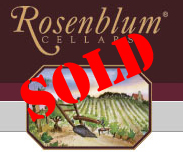 Rosenblum sold to furriners!
Rosenblum sold to furriners!
“Diageo buys Rosenblum for £53m” read the headline in the Financial Times. Why the foreign coverage of a California winery acquisition? Oh yes, Diageo is a drinks multinational based in Britain. With the US dollar tanking, are foreign buyers going to start snapping up American wineries almost as fast as Manhattan pieds-à -terre? Who’s next: Jackson Family? Trinchero? In the case of Rosenblum, let’s hope this reliable producer of zinfandel will continue pumping out the good value vino. [FT.com]
Chew on this
“…if Americans were to reduce meat consumption by just 20 percent it would be as if we all switched from a standard sedan — a Camry, say — to the ultra-efficient Prius.” The meat-guzzler, love it. [NY Times]
Vino Italiano
The next Wine Blogging Wednesday theme has been announced: review an Italian red in seven words. Since having a good picture might help stretch that to 1,007, check out this month’s host and his tips on how to take better pictures of wine bottles. [Spitoon]
Design for wine
Yes, your design could win you free wine in the WBW logo contest, now underway. [WBW.org]
Four questions with…Dr. Vino!
I spoke with Paul Berger and gave him a few tips for NYC wine geeks. [NY Metro]
Wine.com’s dirty tricks, quality of wine blogging on the rise – tasting sized pours
 Playing dirty
Playing dirty
Wine.com, a retailer with big ambitions (but a rocky past) and a largely meh selection of wines, rats on 29 online retailers who illegally sent wine to Washington state. How do they know? Because they were the ones who ordered the wine from those 29 stores! Scandale! For a fascinating thread check out Vinography where the CEO of wine.com appears in the comments along with several anonymous retailers in a clash of the business models. Booooo wine.com!! I am pushing my Cramer-style boooo button! [Vinography]
Mo’ moxie
Winemonger, an internet-only retailer specializing in the wines of Austria, has the chutzpa to offer a mixed case of their “best” wines with a 15% discount as a result of wine.com’s actions — and they have pledged 10% of the proceeds to the Specialty Wine Retailers’ Association, an organization that probably counts many of the 29 “busted” retailers among their members. Enter discount code: ISUCK at checkout. [winemonger]
Mo’ money
Tom Wark, who writes a fiery blog and is the head of the SWRA, has calculated that wine and spirits wholesalers contributed a staggering $50 million to political election campaigns from 2000 – 2006. Yikes! If that’s what they spend on lobbying, just think what the profits are! For a backgrounder on the politics of wine shipping, check out this story from the LA Times. [Fermentation]
Mo’ betta blogs
Wine & Spirits magazine doesn’t put much of their content online, alas. But two of their senior editors have now started blogs. Peter Liem, who lives in and loves Champagne, has started his “Besotted Ramblings and Other Drivel.” Wolfgang Weber, Italian critic, has started “Spume.” Check them out!
Ceci n’est pas une pub
A French court has ruled that newspaper articles that review wine must carry the same health warnings that apply to advertisements to alcohol advertisements. But don’t consume journalism (and blogs) in moderation! [Decanter]
 More carbon footprints
More carbon footprints
Science magazine of the AAAS has a piece entitled “The Wine Divide” in the January 11 issue about the carbon footprint research I did with Pablo Paster. Welcome Science readers! Consider subscribing to the site feed or the monthly email updates. And congratulations to Pablo! As of next week, he will be analyzing the carbon footprint of everything in a new weekly column for Salon.com.
Related: “Developing: the next shipping battle”
Image 1 from winemonger.com
Does wine still merit a sin tax?
 While we were all out during the holidays, a fascinating piece by David Leonhardt about tax and wine ran in the business section of the Times. He met with Philip Cook, a Duke economist and Yellow Tail lover, who argues in his book that wine is getting a free ride from a tax perspective. The federal excise tax on wine has stayed level at $1.07 a gallon (about $0.21 a bottle, a tax that must be paid before the wine leaves the winery) since 1992. So Cook argues that we are “subsidizing” wine since the real tax rate has fallen by 33% in that time. He advocates doubling the excise tax on wine and alcohol since he says that the tax doesn’t cover the “costs” of alcohol on society. Here’s the way Leonhardt sums it up:
While we were all out during the holidays, a fascinating piece by David Leonhardt about tax and wine ran in the business section of the Times. He met with Philip Cook, a Duke economist and Yellow Tail lover, who argues in his book that wine is getting a free ride from a tax perspective. The federal excise tax on wine has stayed level at $1.07 a gallon (about $0.21 a bottle, a tax that must be paid before the wine leaves the winery) since 1992. So Cook argues that we are “subsidizing” wine since the real tax rate has fallen by 33% in that time. He advocates doubling the excise tax on wine and alcohol since he says that the tax doesn’t cover the “costs” of alcohol on society. Here’s the way Leonhardt sums it up:
And for all that is wonderful about wine, beer and liquor, they clearly bring some heavy costs. Right now, the patchwork of alcohol taxes isn’t coming close to covering those costs — the costs of drunken-driving checkpoints, of hospital bills for alcohol-related accidents and child abuse, and of the economic loss caused by death and injury. Last year, some 17,000 Americans, or almost 50 a day, died in alcohol-related car accidents. An additional 65,000 people a year die from other accidents, assaults or illnesses in which alcohol plays a major role.
Wine has ethyl alcohol in it so it contributes to these statistics. But the argument has floated around for centuries that wine is consumed differently than beer and spirits. Since at least the time of Thomas Jefferson, wine has had advocates who see wine as a drink of moderation since it is mostly consumed with food.
Further, since about 1991 when “60 Minutes” popularized the notion of the “French paradox,” there have been many studies underscoring the health benefits of wine, particularly the role of tannins. Heck, resveratrol extends life and promises fat-free gluttony!
So what do you say, does wine still deserve a sin tax? Of course, Cook does not take into account the fact that wine geeks already have been paying a “tax” called the declining dollar. Sobering indeed.
And if we’re opening the discussion of taxes and wine, there’s always the environmental cost of the wine industry in the form of greenhouse gases. A carbon tax, perhaps?
Red, white and blue wine: a wine lover’s guide to the presidential primaries
With the Iowa caucuses (finally!) happening tonight, we need a wine lover’s guide to the presidential election.
Mitt Romney: According to the NYT, he is so “vigilant about nutrition” (read: boring!) that he eats the same meals every day. Anathema to the wine lover! Added bonus: teetotaler. No love from wine geeks.
Mike Huckabee: He’s reputedly a charmer, plays guitar, knows (or knew) how to eat, and jogs every morning. But he’s also a southern Baptist minister, so he doesn’t dance and is a teetotaler. So close, yet so far. Wine pick: “Fre,” a de-alcoholized wine.
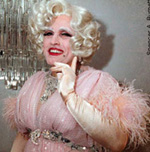 Rudy Giuliani: Rudy used to like Long Island merlot but 9/11 changed everything. Now he’ll drink whatever is local, as long as it is American.
Rudy Giuliani: Rudy used to like Long Island merlot but 9/11 changed everything. Now he’ll drink whatever is local, as long as it is American.
John McCain: He used to be more of a loose cannon eight years ago. Now, the fire in the belly appears as mere embers. His wine is a 10 year old Turley Zinfandel, fiery in it’s youth, now sadly without vigor.
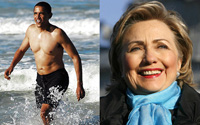 Barack Obama: This man has got style. Heck, one commentator even said he was the “wine track” candidate some time back. So he’s our man for the White House. He’s also quite a blend himself, born in Hawaii to a mother from Kansas and a father from Kenya and lived early on in Indonesia. This eloquent American blend could be none other than one of the finest wines in America, with structure and spice: Ridge Monte Bello.
Barack Obama: This man has got style. Heck, one commentator even said he was the “wine track” candidate some time back. So he’s our man for the White House. He’s also quite a blend himself, born in Hawaii to a mother from Kansas and a father from Kenya and lived early on in Indonesia. This eloquent American blend could be none other than one of the finest wines in America, with structure and spice: Ridge Monte Bello.
Hillary Rodham Clinton: We know Hillary hearts New York but is she cold as ice? Wine pick: Standing Stone, Vidal, ice wine 2005, Finger Lakes.
John Edwards: he’s made it far on his “two Americas” theme. We know what that means–beer America and wine America. We’ll split the difference and put him down for a Franzia box wine.
The wild cards
 Ron Paul: this guy may be crazy–he wants to eliminate the IRS, the Federal Reserve and a host of government departments and restore the gold standard–but if he is, then he is rich and crazy thanks to his $19 million in fund raising last quarter. Wine pick: Armand de Birgnac, Ace of Spades, “gold bottle,” non-vintage Champagne $300.
Ron Paul: this guy may be crazy–he wants to eliminate the IRS, the Federal Reserve and a host of government departments and restore the gold standard–but if he is, then he is rich and crazy thanks to his $19 million in fund raising last quarter. Wine pick: Armand de Birgnac, Ace of Spades, “gold bottle,” non-vintage Champagne $300.
Fred Thompson: This Tennessean seems like a natural fit for Bourbon. No love from wine geeks.
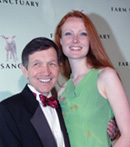 Dennis Kucinich: Given his hhhhot young wife (born 1977), he clearly likes youthful reds. We’ll put him down for a California Pinot, most recent vintage available.
Dennis Kucinich: Given his hhhhot young wife (born 1977), he clearly likes youthful reds. We’ll put him down for a California Pinot, most recent vintage available.
Christopher Dodd: His move to Iowa in a desperate attempt to score fourth place makes him seem pandering. And nothing tries harder to be a crowd-pleaser yet fails to inspire more than Merlot.
Bill Richardson: He’s big and he claims to have the most foreign policy experience. Wine pick: the brawny 2004 Numanthia from Spain.
Related: “Bush-Kerry 2004: an election guide for wine lovers“
